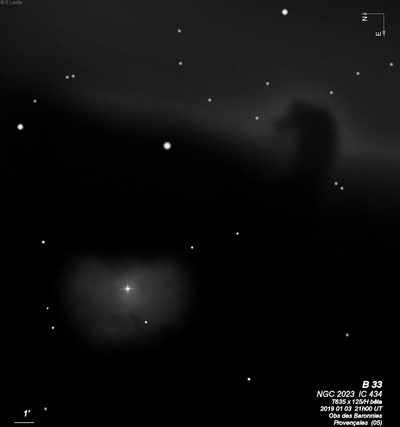Flame Nebula,Orion B
Flame Nebula,Orion B

Williamina Fleming discovered IC 434 on Harvard College Observatory plates in 1883. Edward Pickering announced the discovery (along with a number of other Orion nebulae) in the 1890 Harvard Annals publication (1890AnHar..18..113P). She also described the dark notch (later dubbed the "Horsehead") as "A large nebulosity extending nearly south the Zeta Orionis for about 60'. More intense and well marked on the following side with a semicircular indentation 5' in diameter 30' south of Zeta. All good plates of this region show this object, and it has been used here as a test for some time." Dreyer didn't mention the "indentation" in the IC description.
Harold Corwin comments that "Some people have suggested that it was actually found by William Herschel. This is not true; WH's comment (see Latusseck, J. Astron. Data 14, 4, 2008 where it is reprinted) "Wonderful black space included in Nebulosities" refers to NGC 2024, not to IC 434."
But Wolfgang notes that on 1 Feb 1786 (sweep 518), WH recorded a large region of nebulosity extending roughly 2° north-south, not far east of IC 434. He noted "I am pretty sure the places of which these are the boundaries are all full of diffused milky nebulosity; but notwithstanding I used every means of ascertaining it by motion of the telescope, my range was neither far enough, nor sufficiently quick to put it beyond doubt. He assigned it internal discovery number (1321), which became H. V 35 (first of 4 different fields associated with that designation). Wolfgang Steinicke feels it may apply to IC 434, though Herschel's RA is about 3 minutes too large, so this identification is very uncertain.
300/350mm - 13.1" (1/11/86): using an H-beta filter IC 434 appears a very faint, very large, very elongated strip of nebulosity running south of Zeta Orionis for almost one degree in a N-S direction. There is a well-defined sharp edge along the east side while the west side fades off into the background. Contains the famous dark nebula B33 = "Horsehead Nebula" as a dark "notch". IC 434 extends beyond NGC 2023 off the east edge and the star density drops off significantly east of IC 434 whereas a number of faint stars are pepper the field to the west of IC 434. This is one of the few emission nebulae that responds very well to a H-Beta filter. Extremely difficult without filter.
13.1" (1/18/85): visible with direct vision with H-Beta filter and striking with averted. The snout was suspected. The contrast between B33 and the sky was high with the background jet black and sharply outlined against the easy glow of IC 434. Best view with 24mm.
400/500mm - 17.5" (12/26/00 and 12/28/00): at 100x using an H-beta filter, the huge IC 434 strip was very prominent and easy to follow south from Zeta Orionis throughout the entire 50' field of view. The boundary was razor-sharp along its eastern edge against a background sky darkened by the H-beta filter. The Horsehead was very easy to view as a nearly black, semi-circular 4' indentation that protruded into the nebulosity. With averted vision there was a short extension or knob on the north side. This forms the snout of the horse and with concentration faint nebulosity is visible just below (east) of the snout.
17.5" (10/8/88): easily held with direct vision using the H-beta filter. The head or snout protrudes to the north.
17.5" (9/14/85 and 10/12/85): the Horsehead Nebula appears as a jet black dark nebula using an H-beta filter at 84x superimposed against the fairly prominent emission nebula IC 434. Appears as a semi-circular indentation or "bite" of 5' diameter along the sharply defined eastern edge of IC 434 "strip" which extends through field in a N-S orientation. Significant contrast gain with and H-Beta filter which renders the background sky and B33 extremely dark. Difficult to see the "snout" feature which protrudes to the north but it is detectable. Mag 8.5 SAO 132451 lies 8' N.
600/800mm - 24" (2/13/18): I was surprised to easily pick up the IC 434 strip extending south of Zeta Orionis unfiltered at 124x (21mm Nagler). Although the Horsehead wasn't prominently visible, I could also see the notch unfiltered!
24" (1/21/12): the view of the Horsehead through a 24" f/4.1 Starmaster using a Collins I3 image intensifier mated with a narrowband H-alpha filter at the Mauna Kea visitor center (9300') was absolutely stunning. The outline stood out in extremely sharp relief like a photograph and the dark cloud was pitch black against the bright background. I'm not sure of the magnification used but the field was 30' or less and the Horsehead was large enough to show exquisite detail in the outline.
Notes by Steve Gottlieb